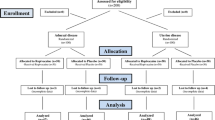Summary
The pain following gynecological laparoscopic surgery is less intense than that following open surgery; however, patients often experience visceral pain after the former surgery. The aim of this study was to determine the effects of preemptive ketamine on visceral pain in patients undergoing gynecological laparoscopic surgery. Ninety patients undergoing gynecological laparoscopic surgery were randomly assigned to one of three groups. Group 1 received placebo. Group 2 was intravenously injected with preincisional saline and local infiltration with 20 mL ropivacaine (4 mg/mL) at the end of surgery. Group 3 was intravenously injected with preincisional ketamine (0.3 mg/kg) and local infiltration with 20 mL ropivacaine (4 mg/mL) at the end of surgery. A standard anesthetic was used for all patients, and meperidine was used for postoperative analgesia. The visual analogue scale (VAS) scores for incisional and visceral pain at 2, 6, 12, and 24 h, cumulative analgesic consumption and time until first analgesic medication request, and adverse effects were recorded postoperatively. The VAS scores of visceral pain in group 3 were significantly lower than those in group 2 and group 1 at 2 h and 6 h postoperatively (P<0.05 and P<0.01, respectively). At 2 h and 6 h, the VAS scores of incisional pain did not differ significantly between groups 2 and 3, but they were significantly lower than those in group 1 (P<0.01). Groups 1 and 2 did not show any differences in visceral pain scores at 2 h and 6 h postoperatively. Moreover, the three groups showed no statistically significant differences in visceral and incisional pain scores at 12 h and 24 h postoperatively. The consumption of analgesics was significantly greater in group 1 than in groups 2 and 3, and the time to first request for analgesics was significantly longer in groups 2 and 3 than in group 1, with no statistically significant difference between groups 2 and 3. However, the three groups showed no significant difference in the incidence of shoulder pain or adverse effects. Preemptive ketamine may reduce visceral pain in patients undergoing gynecological laparoscopic surgery.
Similar content being viewed by others
References
Kwon YS, Kim JB, Jung HJ, et al. Treatment for postoperative wound pain in gynecologic laparoscopic surgery: topical lidocaine patches. J Laparoendosc Adv Surg Tech A, 2012,22(7):668–673
Reddi D, Curran N. Chronic pain after surgey: pathophysiology, risk factors and prevention. Postgrad Med J, 2014,90(1062):222–227
Marx J. Neuroscience. Locating a new step in pain’s pathway. Science, 2004,304 (5672):811–816
Launo C, Bassi C, Spagnolo L, et al. Preemptive ketamine during general anesthesia for postoperative analgesia in patients undergoing laparoscopic cholecystectomy. Minerva Anestesiol, 2004,70(10):727–734
Schonfeld CL, Hiemeis S, Kampik A. Preemptive analgesia with ropivacaine for pars plana vutrectpmy: randomized controlled trial on efficacy and required dose. Retina, 2012,32(5):912–917
Kayacan N, Cete N, Ertugrul F, et al. Analgesic treatment after laparoscopic gynaecological surgery: wound or intraperitoneal instillation. Reg Anesth Pain Med, 2007, 32(5):157
Jiménez Cruz J, Diebolder H, Dogan A, et al. Combination of pre-emptive port-site and intraoperative intraperitoneal ropivacaine for reduction of postoperative pain: a prospective cohort study. Eur J Obstet Gynecol Reprod Biol, 2014,179:11–16
Somaini M, Brambillasca P, Ingelmo PM, et al. Effects of peritoneal ropivacaine nebulization for pain control after laparoscopic gynecologic surgery. J Minim Invasive Gynecol, 2014,21(5):863–869
Kaufman Y, Hirsch I, Ostrovsky L, et al. Pain relief by continuous intraperitoneal nebulization of ropivacaine during gynecologic laparoscopic surgery—a randomized study and review of the literature. J Minim Invasive Gynecol, 2008,15(5):554–558
Chou YJ, Ou YC, Lan KC, et al. Preemptive analgesia installation during gynecologic laparoscopy: a randomized trial. J Minim Invasive Gynecol, 2005,12(4): 330–335
Michael R. Perioperative use of non-steroidal anti-inflammatory drugs: evaluation of their effects on analgesia, anaesthesia, haemostasis and stress response. Acta Univ Tamper Ser A, 1993,368:12–83
Schuligoi R, Josic M, Heinemann A, et al. Gastric acid—evoked c-fos messenger RNA expression in rat brainstem is signaled by capsaicin-resistant vagal afferents. Gastroenterology, 1998,115(3):649–660
Bon K, Lanteri-Minet M, de Pommery J, et al. Cyclophosphamide cystitis as a model of visceral pain in rats: a survey of hindbrain structures involved in visceroception and nociception using the expression of c-fos and Krox-24 proteins. Exp Brain Re, 1996,108(3):404–416
Segawa H, Moil K, Kasai K, et al. The role of the phrenic nerves in stress response in upper abdominal surgery. Anesth Analg, 1996,82(6):1215–1224
Coderre TJ, Katz J, Vaccarino AL, et al. Contribution of central neuroplasticity to pathological pain: review of clinical and experimental evidence. Pain, 1993,52(3): 259–285
Wall PD. The prevention of postoperative pain. Pain, 1988,33:289–290
Papaziogas B, Argiriadou H, Papagiannopoulou P, et al. Preincisional intravenous low-dose ketamine and local infiltration with ropivacaine reduces postoperative pain after laparoscopic cholecystectomy. Surg Endosc, 2001,15(9):1030–1033
Ji Y, Traub RJ. Spinal NMDA receptors contribute to neuronal processing of acute noxious and nonnoxious colorectal stimulation in the rat. J Neurophysiol, 2001,86(4):1783–1791
Castroman PJ, Ness TJ. Ketamine, an N-methyl-D-aspartate receptor antagonist, inhibits the spinal neuronal responses to distension of the rat urinary bladder. Anesthesiology, 2002,96(6):1410–1419
Strigo IA, Duncan GH, Bushnell MC, et al. The effects of racemic ketamine on painful stimulation of skin and viscera in human subjects. Pain, 2005,113(3): 255–264
De Kock M, Lavand P, Waterloos H. “Balanced analgesia” in the perioperative period: is there a place for ketamine? Pain, 2001,92(3):373–380
Schmid RL, Sandler AN, Katz J. Use and efficacy of low-dose ketamine in the management of acute postoperative pain: a review of current techniques and outcomes. Pain, 1999,82(2):111–125
Author information
Authors and Affiliations
Corresponding author
Additional information
This study was supported by the Key Technologies R&D program of Henan Province, China (No. 201503178)
Rights and permissions
About this article
Cite this article
Lin, Hq., Jia, Dl. Effect of preemptive ketamine administration on postoperative visceral pain after gynecological laparoscopic surgery. J. Huazhong Univ. Sci. Technol. [Med. Sci.] 36, 584–587 (2016). https://doi.org/10.1007/s11596-016-1629-0
Received:
Accepted:
Published:
Issue Date:
DOI: https://doi.org/10.1007/s11596-016-1629-0




